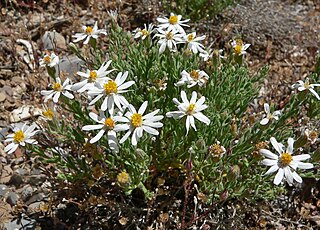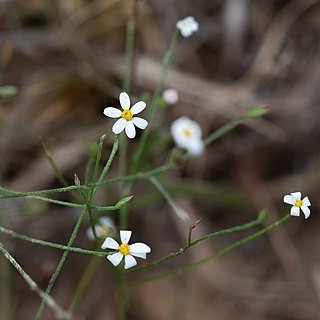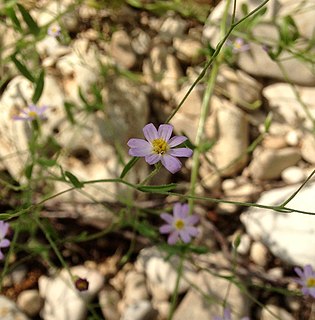
Astereae is a tribe of plants in the family Asteraceae that includes annuals, biennials, perennials, subshrubs, shrubs, and trees. Plants within the tribe are present nearly worldwide divided into 170 genera and more than 2,800 species, making it the second-largest tribe in the family behind Senecioneae. They are found primarily in temperate regions of the world.

Isocoma, commonly called jimmyweed or goldenweed, is a genus of North American semi-woody shrubs in the family Asteraceae. It is found in the semi-arid areas of Southwestern United States and Mexico.

Ericameria nauseosa, commonly known as Chamisa, rubber rabbitbrush, and gray rabbitbrush, is a North American shrub in the sunflower family (Aster). It grows in the arid regions of western Canada, western United States and northern Mexico.

Chaetopappa is a genus of plants in the family Asteraceae which are known generally as leastdaisies.

Erigeron strigosus is a species of flowering plant in the family Asteraceae known by the common names prairie fleabane, common eastern fleabane, and daisy fleabane.

Chaetopappa ericoides is a species of flowering plant in the family Asteraceae known by the common names rose heath and heath-leaved chaetopappa. It is native to the southwestern and western Great Plains regions of the United States, plus northern Mexico. It is found in California, Nevada, Arizona, Utah, New Mexico, Colorado, Wyoming, Texas, Oklahoma, Kansas, Nebraska, Chihuahua, Coahuila, Sonora, Durango, Zacatecas, San Luis Potosí, and Nuevo León.

Ericameria greenei is a species of flowering shrub in the daisy family known by the common name Greene's goldenbush. It is native to the mountains of the western United States in Washington, Idaho, Oregon, and the northern California as far south as Lake and Tuolumne Counties.
Columbiadoria is a small North American genus of flowering plants in the family Asteraceae.
Erigeron serpentinus is a rare species of flowering plant in the family Asteraceae known by the common names serpentine fleabane and serpentine daisy. It is endemic to Sonoma County, California, where it is known from three occurrences in and around The Cedars, in the Coast Ranges east of Salt Point and west of Healdsburg. There are an estimated 1100 individuals in existence. The Cedars is a canyon habitat with serpentine soils surrounded by non-serpentine terrain; it is home to several rare serpentine-endemic plant species. This daisy was discovered there and described to science in 1992.
Chaetopappa hersheyi is a rare perennial plant species of plant called Hershey's cliff daisy, in the sunflower family. The epithet "hersheyi" honors the plant's discoverer, Alfred Hershey who collected it in 1944. It was formally described by Sidney Fay Blake in 1946.

Chaetopappa asteroides, called the tiny lazy daisy, or Arkansas leastdaisy, is a North American species of plants in the family Asteraceae. It is native to the southern Great Plains of the United States and also to northeastern Mexico.

Chaetopappa bellidifolia , called the Edwards lazy daisy, or whiteray leastdaisy, is a North American species of plants in the family Asteraceae. It has been found only in central Texas, largely in the Edwards Plateau.
Chaetopappa bellioides, called the pretty lazy daisy, or manyflower leastdaisy, is a North American species of plants in the family Asteraceae. It native to northern Mexico and to the Rio Grande Valley in western and southern Texas.
Chaetopappa effusa, called the spreading lazy daisy, or spreading leastdaisy, is a North American species of plants in the family Asteraceae. It has been found only in Texas, largely on the Edwards Plateau.
Chaetopappa parryi, called the Parry's lazy daisy, or Parry's leastdaisy, is a North American species of plants in the family Asteraceae. It is native to northeastern Mexico and to the Big Bend region of western Texas.
Ericameria obovata is a North American species of flowering shrubs in the daisy family. It has been found only in the state of Utah in the western United States.
Ericameria watsonii is a North American species of flowering shrubs from the daisy family. It is native to the states of Nevada, Utah, and Arizona in the southwestern United States.

Ericameria palmeri is a North American species of flowering shrubs in the daisy family. It is native to southern California in the United States and to the state of Baja California in Mexico.
Ionactis elegans, the Sierra Blanca least-daisy, is a rare North American species in the family Asteraceae. It has been found only in New Mexico in the western United States.









